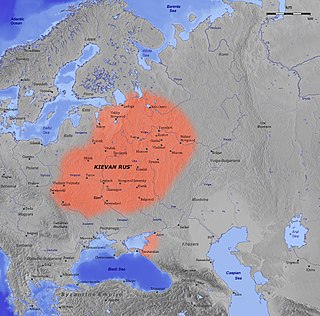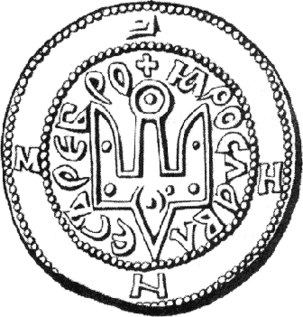
Vsevolod I Yaroslavich, ruled as Grand Prince of Kiev (Kyiv) from 1078 until his death.

Yaroslav the Wise or Yaroslav I Vladimirovich was the Grand Prince of Kiev from 1019 until his death. He was also the Prince of Novgorod on three occasions, uniting the principalities for a time. Yaroslav's baptismal name was George after Saint George.

Vladimir-Suzdal, also Vladimir-Suzdalian Rus', formally known as the Grand Duchy of Vladimir (1157–1331), was one of the major principalities that succeeded Kievan Rus' in the late 12th century, centered in Vladimir-on-Klyazma. With time the principality grew into a grand duchy divided into several smaller principalities. After being conquered by the Mongol Empire, the principality became a self-governed state headed by its own nobility. A governorship of principality, however, was prescribed by a jarlig issued from the Golden Horde to a Rurikid sovereign.

Iziaslav Yaroslavich was a Kniaz' (Prince) of Turov and Veliki Kniaz.
Sviatoslav II Iaroslavich or Sviatoslav II Yaroslavich was Grand Prince of Kiev between 1073 and 1076. He was born as a younger son of Grand Prince Yaroslav the Wise. His baptismal name was Nicholas.

Yaroslav II, Christian name Theodor (Феодо́р) was the Grand Prince of Vladimir (1238–1246) who helped to restore his country and capital after the Mongol invasion of Rus'.
Oleg Svyatoslavich was a Rurikid prince whose equivocal adventures ignited political unrest in Kievan Rus' at the turn of the 11th and 12th centuries.

Mstislav Mstislavich the Daring prince of Tmutarakan and Chernigov, was one of the most popular and active princes of Kievan Rus' in the decades preceding the Mongol invasion of Rus'. He was the maternal grandfather of Prince Alexander Nevsky, Prince of Novgorod, Grand Prince of Kiev and Grand Prince of Vladimir. He also was the maternal grandfather of prince Leo of Galicia, who became Grand Prince of Kiev.

Roman Mstislavich, known as Roman the Great was a Rus’ prince, Grand Prince of Kiev, member of the Rurik dynasty.

The Principality of Chernigov was one of the largest and most powerful states within Kievan Rus'. For a time the principality was the second most powerful after Kiev. The principality was formed in the 10th century and maintained some of its distinctiveness until the 16th century. The Principality of Chernigov consisted of regions of modern day Russia, Belarus, and Ukraine.
Mstislav Vladimirovich was the earliest attested prince of Tmutarakan and Chernigov in Kievan Rus'. He was a younger son of Vladimir the Great, Grand Prince of Kiev. His father appointed him to rule Tmutarakan, an important fortress by the Strait of Kerch, in or after 988.

The intervention in the Kievan succession crisis of 1015–1019 by the Polish ruler Bolesław the Brave was an episode in the struggle between Sviatopolk I Vladimirovich and his brother Yaroslav for the rulership of Kiev (Kyiv) and Kievan Rus'. It occurred when Sviatopolk's father-in-law Bolesław, ruler of Poland, intervened on Sviatopolk's behalf.

The inner Principality of Kiev was a medieval East Slavic state, situated in central regions of modern Ukraine around the city of Kiev (Kyiv).
The Kiev uprising of 1068 was a revolt against Grand Prince Iziaslav Yaroslavich of Kiev in the aftermath of a Kievan Rus’ defeat at the hands of the Cumans at Battle of the Alta River near the city of Pereiaslavl, southeast of Kiev.

Yaropolk Izyaslavich was a Knyaz (prince) during the eleventh-century in the Kievan Rus' kingdom and was the King of Rus (1076–1087). The son of Grand Prince Izyaslav Yaroslavich by a Polish princess named Gertruda, he is visible in papal sources by the early 1070s but largely absent in contemporary Rus sources until his father's death in 1078. During his father's exile in the 1070s, Yaropolk can be found acting on his father's behalf in an attempt to gain the favor of the German emperors and the papal court of Pope Gregory VII. His father returned to Kiev in 1077 and Yaropolk followed.

Kievan Rus', sometimes Kyivan Rus', was a state in Eastern and Northern Europe from the late 9th to the mid-13th century. Encompassing a variety of polities and peoples, including East Slavic, Norse, and Finnic, it was ruled by the Rurik dynasty, founded by the Varangian prince Rurik. The modern nations of Belarus, Russia, and Ukraine all claim Kievan Rus' as their cultural ancestor, with Belarus and Russia deriving their names from it. At its greatest extent in the mid-11th century, Kievan Rus' stretched from the White Sea in the north to the Black Sea in the south and from the headwaters of the Vistula in the west to the Taman Peninsula in the east, uniting the East Slavic tribes.

The Rurik dynasty, also known as the Rurikid dynasty or Rurikids, was a noble lineage founded by the Varangian prince Rurik, who established himself in Novgorod around the year AD 862. The Rurikids were the ruling dynasty of Kievan Rus' before it finally disintegrated in the mid-13th century, as well as the successor Rus' principalities and Rus' prince republics of Novgorod, Pskov, Vladimir-Suzdal, Ryazan, Smolensk, Galicia-Volhynia, Chernigov, and the Grand Duchy of Moscow.
Mstislav II Svyatoslavich was a Rus' prince. His baptismal name was Panteleymon. He was probably prince of Kozelsk (1194–1223), of Novgorod-Seversk (1206–1219), and of Chernigov (1215/1220–1223). He was killed in the Battle of the Kalka River.
Oleg III Svyatoslavich was a Rus' prince. His baptismal name was Feodosy. He was prince of Vshchizh, of Novgorod-Seversk (1200–1201), and of Chernigov (1201/1202–1204).
Yaroslav II Vsevolodovich was a Rus’ prince. He was prince of Ropesk, of Starodub (1166–1176), and of Chernigov (1176–1198).













